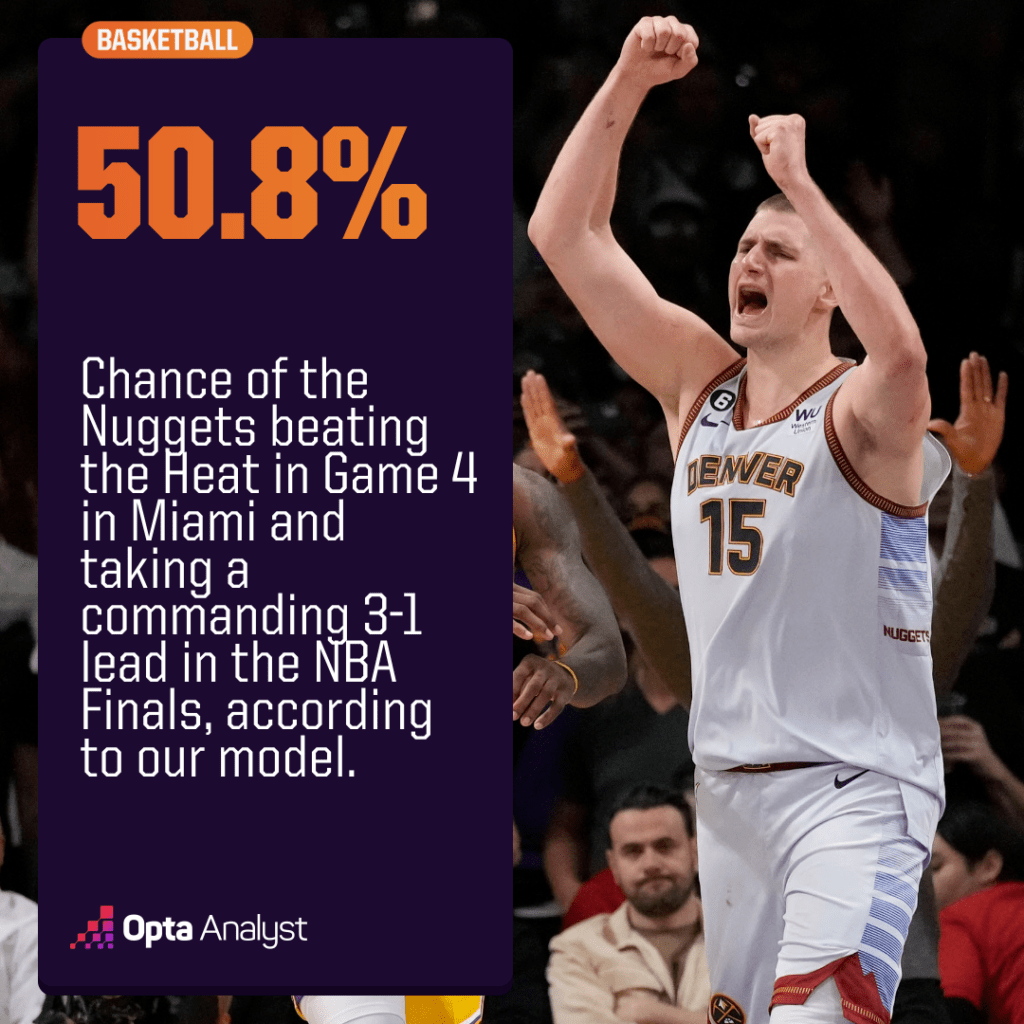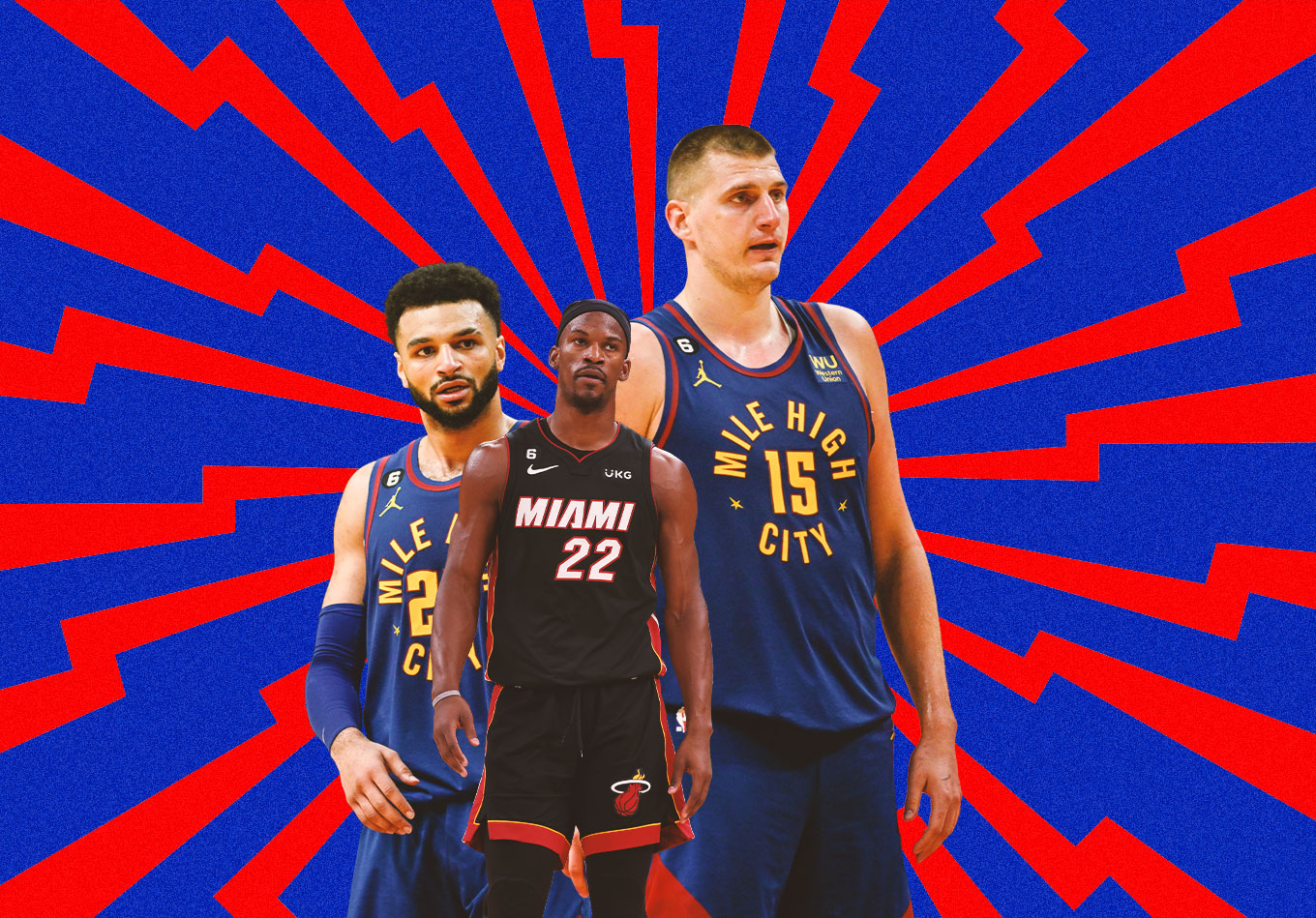After Denver bounced back in convincing fashion, we’re breaking down our Nuggets vs. Heat prediction and the keys for each side in this critical Game 4 matchup.
After losing in Game 2, the Denver Nuggets regained home-court advantage in the NBA Finals with a 109-94 victory over the Miami Heat at the Kaseya Center.
Some will look at Game 2 and point to Miami’s 31.4% shooting from 3 (11 of 35) as the main culprit for this outcome. But is that really the case? Did the Heat lose simply because they weren’t hitting their 3s? Or did Denver do something different?
And if so, is there any way that Miami can respond to even the series in Game 4?
The Truth About Game 3
Before we dig into Miami’s shooting, we should pay homage to the two main stars of the night: Nikola Jokić (32 points, 21 rebounds, 10 assists) and Jamal Murray (34, 10, 10). The dynamic duo made history in Game 3, becoming the first teammates to both record a 30-point triple-double in the same game, let alone an NBA Finals game.
We’ve already touched on the interactions between these two during our postseason coverage. In Game 1, they earned comparisons to Kobe Bryant and Shaquille O’Neal after they defused every defensive matchup that the Heat threw their way.
Realizing that they couldn’t neutralize the entire beast, Miami figured it was best to cut off one of the serpent’s heads. So, in Game 2, they responded by throwing more length at Murray to disrupt his cadence and rhythm. As a result, Murray took only 15 shots in Game 2 (with only nine coming in the first three quarters).
Well, as the old adage goes, you either adapt or die. And the NBA playoffs are is no different. In Game 3, Murray looked much more comfortable with the size Miami was throwing at him, oftentimes looking like he was in complete control out there on the court.
The perfect example of this comes at the end of the second quarter.
In this play, Murray draws the attention of two defenders after some two-man action with Jokić. He starts his drive, only to whip out a hesitation move that makes Bam Adebayo think for a split second that he’s going to flip it back to Jokić. This opens up a crease, and Murray explodes right through it. That, my friend, is how you adapt!
Murray getting his swagger back enabled him and Jokić to return to their two-man demolition of the Heat, relentlessly spamming pick-and-rolls down their throat. But the thing is, even with Murray neutralized to a degree in Game 2, the offense was still excellent. The real problem was the defense, which forfeited enough points to let Miami keep pace.
In Game 3, Denver held Miami to a 99.6 offensive rating – a massive upgrade from the 123.6 offensive rating the Heat hung on them in Game 2. How did Denver tighten up the screws?
Some of it was Miami not shooting as well as it did in Game 2. The Heat shot 16 of 30 (53.3%) on open/wide-open 3-point attempts (per NBA.com). Meanwhile, in Game 3, they shot 10 of 25 (40%) on those shots.
But most of their success was due to improved execution (they were notably sloppy in large parts of Game 2) and returning to their Game 1 roots. What do we mean by that?
Did you notice that Miami shot fewer open/wide-open 3s in Game 3 (25) than it did in Game 2 (30)? That’s because Denver (like it did in Game 1) did a good job of keeping actions contained and not conceding automatic advantages that Miami could generate open 3-point looks out of.
When it came to screening actions that involved Gabe Vincent, Jimmy Butler or Max Strus, Denver would play them in a deep drop and dare them to beat them with their pull-up jumper. And when Butler would mismatch hunt Murray or Kentavious Caldwell-Pope, Denver would concede the switch rather than try to hedge the screen and recover.
The Nuggets decided they would rather avoid having everyone scramble around when they could manage it and keep the action flat (meaning everyone stays home).
Check out these clips for a better explanation:
When Denver has Jokić drop, it also allows him to stay closer to the paint and use his statuesque frame to safeguard the interior.
While all the headlines will be about his gaudy offensive numbers (rightfully so), he also had a stellar game as a rim protector.
In total, Jokić defended 11 shots within 6 feet of the rim – holding Heat players to 36.4% shooting on those attempts (per NBA.com). As a team, the Nuggets held Miami to just 34 points in the paint for the second straight game (outscoring the Heat 60-34).
Overall, by protecting the paint and lowering the number of open 3s they allowed (and some shooting regression by Miami), Denver was able to stunt the Heat.
What’s Next for the Heat
Game 2 showed us that the formula for Miami to win this series is to chip away at Denver’s offense just enough for its offense to outscore the Nuggets.
For the first part of the equation to come to fruition, Miami is going to have to figure out how to throw a wrench in the Jokić/Murray two-man combination by taking one of them off the board. Jokić (the best offensive player on the planet) is not getting taken off the board.
It has to be Murray.
And just because Murray became comfortable with one strategy Miami threw at him doesn’t mean he has become immune to disruption. For instance, after Game 1, when we talked about the “main” defensive coverages, we left out some nuance.
We mentioned that when Miami tried to bother Murray by throwing two defenders at him, he could just flip it to Jokić for an easy look. But there are different ways to send two defenders at someone.
The way we were talking about after Game 1 is known as a “soft trap/show.” In Game 3, Miami experimented with more “hard trapping/showing.” And as the clip above suggests, this led to some positive results at times.
The Heat could look to incorporate even more of this coverage in their Game 4 plan. And who knows, maybe it chips at the Nuggets’ efficiency just enough to give their offense a chance.
Speaking of offense, Miami needs to find a way to get Denver to send two defenders at the ball more frequently. The Heat need to find a way to get the Nuggets scrambling so that they can utilize their crisp ball movement to find open looks.
This means that they are going to need to hit enough dribble pull-ups to force Denver to scrap the drop coverage or play more players that the Nuggets won’t use drop coverage against.
Two names you might have noticed we left out of the drop conversation are Robinson and Lowry. That’s because when those two were engaged in screening actions (whether via dribble handoff or pick-and-roll) in Game 3, Denver sent two defenders at them. Like this:
In Game 4, Erik Spoelstra might opt to lean on these two for more minutes (interestingly enough, Robinson only played 17 minutes in Game 3 after a huge Game 2 performance) if Strus and Vincent don’t have it going.
Vincent and Strus combined for 10 points on 3-of-17 shooting in Game 3, while Robinson, Lowry and Caleb Martin did have their moments with 28 combined points on 11-fo-23 shooting.
Tyler Herro, the Heat’s third-leading scorer at 20.1 per game during the regular season, could be an option, but his status remains uncertain as he recovers from a broken hand he suffered in the opening game of the playoffs against the Milwaukee Bucks.
Miami needs to find a way to slow down this Denver machine and rediscover its own offensive engine if it hopes to tie up this series and turn this best-of-seven series into a best of three.
Game 4 Win Probability: Who Has the Edge?
In terms of the moneyline, sportsbooks have the Nuggets as the best bets (-165) in Game 4 and the Heat as the underdogs (+140).
But what is our win probability model’s prediction for who will win in Miami?
The model calculates each team’s chances of winning (in this case, Friday’s Game 4 on ABC) based on thousands of simulations.
It incorporates our adjusted team ratings (including overall adjusted team rating, adjusted offensive rating, and adjusted defensive rating), accounts for recency bias (so it gives more weight to teams playing well), and for how well teams performed against other good teams.

After the model gave the Nuggets a 50.2% chance to win Game 3, the projection remains close heading into Friday’s showdown. It gives the Nuggets just a 50.8% probability of claiming a 3-1 series lead heading back to Denver.
Like this? Follow us on Twitter for more.
